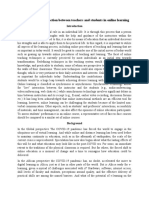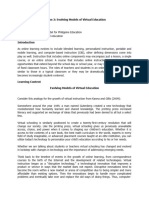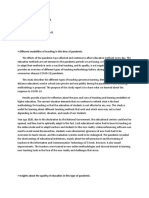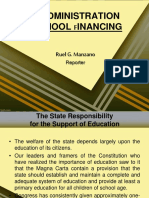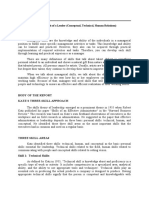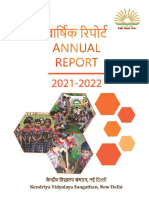Task 4
Task 4
Uploaded by
Jon GraniadaCopyright:
Available Formats
Task 4
Task 4
Uploaded by
Jon GraniadaOriginal Description:
Original Title
Copyright
Available Formats
Share this document
Did you find this document useful?
Is this content inappropriate?
Copyright:
Available Formats
Task 4
Task 4
Uploaded by
Jon GraniadaCopyright:
Available Formats
1.
How do community involvement in school and community education create social
change? What are some of the changes created?
According to a recent policy brief from the National Education Association (NEA),
“when schools, parents, families, and communities work together to support learning,
students tend to earn higher grades, attend school more regularly, stay in school longer,
and enroll in higher level programs”. With these important benefits in mind, it is clear that
a focus on increasing community involvement programs and opportunities should be a
consistent goal for your school.
All communities value education for their children. Families either have power to take
command and use it for the wellbeing of their children’s education or outsiders exploit
and dominate those who are powerless and leave them worse off. Education as one of
the public goods, therefore, must not only be valued by the community and the people,
but must be advanced and protected or preserved. This is the responsibility of all
community role players, stakeholders as well as educational institutions.
From that, students will be expected to pursue more on their studies and will become
beneficial to the society and educated when they become professionals in different
fields. Some of the societal benefits of education are: a) promotes equality and
empowerment b) promotes good citizenship and civic involvement c) reduces crime; d)
reduces gender-based violence; e) reduces child marriage; and f) reduces maternal
death rates.
2. Aside from the examples given in our class, cite and discuss at least three
innovative cases of community involvement related to education that are feasible
for implementation during the new normal.
Conduct a livelihood training to parents and students through virtual or face-to-face (if
possible) by inviting experts or livelihood trainers. In this way, they can engage
themselves into business to earn profits for their daily living specially to the parents
that cannot go out to their work brought by the pandemic.
Installation of public wifi to every barangay to support the online classes of students
by cooperating with the barangay officials and other benevolent donors.
Educating the community about the new normal by conducting online or face-to-face
lectures and the other opportunities they can do to cope up with the situation by
cooperating with expert lecturers
Adopting the Gulayan sa Paaralan Program or other agricultural activities that could
help benefit the society and the people as well.
3. Discuss the symbiotic relationship between 1) the school or any public or private
agency/organization and 2) community in the implementation of fieldworks and
community education.
School and community partnerships are a shared responsibility and reciprocal
process whereby schools and other community agencies and organizations engage
families in meaningful and culturally appropriate ways, and families take initiative to
actively supporting their children’s development and learning. Schools and community
organizations also make efforts to listen to parents, support them, and ensure that they
have the tools to be active partners in their children’s school experience. Partnerships
are essential for helping students achieve at their maximum potential and, while parent
and community involvement has always been a cornerstone of public schools, greater
recognition and support of the importance of these collaborative efforts is needed.
The school and the community are the mainsprings of effective and powerful
forces that can create a wholesome climate for mutual gains and betterment. They can
forge a kind of partnership where both are willing to share information as well as
responsibilities to the best interest of the children while in school. Likewise, when dealing
with members of the community. Parents from the community are ready to offer much-
needed assistance in terms of resources while teachers are equally committed to spend
time, effort, and expertise in serving the school children. Ensuring strong alliance is
guaranteed to foster sound academic practices in the school, civic mindedness, and
public accountability in the community. A positive affiliation is an overwhelming bond that
all stakeholders are willing to be part of.
4. Identify and discuss at least three community education programs/projects that
are realistic and achievable and can be implemented by your respective agency.
Discuss how these community education programs are implemented under the
new normal.
Online education as an imperative for institutions
Online teaching and learning are going to be more regular and teachers must be
prepared to teach online. Online learning is not new. What is new is that schools are
embracing it as vital to how the next generation of learners are taught.
In a world where disasters and disruptions are increasingly becoming the norm, it is
imperative for schools and universities to train teachers on how to teach online and to
encourage them to devote their time to teaching online at least as a drill mechanism to
prepare for unexpected events. It is not just about the pandemic we are experiencing
right now. Other events, such as earthquakes, floods and other calamities will compel
teachers and students to stay home to teach or study online.
We will see more classes being conducted through web video conferencing. Some
schools and universities will use a learning management system (LMS), such as Google
Classroom, Moodle, Blackboard Learn and Canvas, to enable students to complete
assignments, deliver presentations, take assessments and receive immediate feedback
from their teachers online.
Use of open textbooks
With the Covid-19 crisis forcing schools into online instruction, we will see a rise in the
adoption of open educational resources (OER) as an inexpensive alternative to
traditional textbooks. Over the years, many educational materials have been developed
and made freely available for teachers and students to use, adapt, share and reuse.
Low-cost (and even free) quality educational content is ideal for online instruction; it is in
a digital format and it can be embedded into a school’s LMS.
Many sites offer a wide range of content and tools to help implement OER for just about
any course, such as MIT Open Courseware, OER Commons, Lumen Learning, Merlot II
and OpenStax CNX. Recently, DepEd launched its own open online learning platform,
DepEd Commons, to support public school learners and expanded its features to cater to
private school students.
Blended learning and flipped classrooms
As governments ease out of lockdowns, we will begin to see schools adopting the
blended learning approach. Those who are necessitated to move to online learning
during the Covid-19 crisis will start to realize the full benefits of virtual education as
teachers and students return to their physical classrooms. The conscious and careful
blending of face-to-face instruction and online methods can draw the best of both worlds
and create the best teaching and learning experience.
Some schools will also start combining blended learning with a flipped classroom
approach. In a flipped classroom, the typical classroom lecture and homework elements
are reversed. At home, the students watch short video lectures and other asynchronous
content, while activities traditionally assigned as homework are now done in-class with
the teacher answering student questions and helping them apply course concepts during
class time.
Online education at the core of every school’s strategic plan
Online education will be a priority not only as a potential source of revenue, but also
acknowledged as core to every school’s strategic plan for institutional resilience and
academic continuity. For school leaders to manage efficiently the transition to online and
blended learning environments, most schools will invest in learning design by hiring
instructional designers and educational technology consultants. Other schools lacking in
finances will find it more viable to outsource some of its educational resources,
capabilities and processes. Some schools will depend on online learning providers to run
their online programs.
Despite technological advancements, the difficulties and limitations posed by technology
are challenges that every teacher faces when using technology inside the classroom.
However, this should not prevent or discourage teachers from using tech. Every teacher
has to try. Otherwise, teachers will lose their relevance in this digital age.
The Covid-19 crisis presents an opportunity for the education sector to come together,
forge connections and share what works. We may have not seen this before the crisis,
but we are missing a greater opportunity if we do not do this now.
You might also like
- The Why and How of School and Community PartnershipDocument5 pagesThe Why and How of School and Community PartnershipIvy Gonzaga100% (2)
- Bartendertrainingmanualbydahlstromrideout 161201172455 PDFDocument51 pagesBartendertrainingmanualbydahlstromrideout 161201172455 PDFJon GraniadaNo ratings yet
- Work ImmersionDocument6 pagesWork ImmersionRomelo Muldez74% (35)
- Reflective Paper On Current Issues and Trends in Education: I. II. BodyDocument11 pagesReflective Paper On Current Issues and Trends in Education: I. II. BodyCaironisah Mocadi HmdNo ratings yet
- CHAPTER6Document6 pagesCHAPTER6Layca BolontonNo ratings yet
- PorposalDocument12 pagesPorposalStarLord JedaxNo ratings yet
- "Maslow Before Bloom" Should Be The New Battlecry in EducationDocument6 pages"Maslow Before Bloom" Should Be The New Battlecry in EducationLEJEN PILARNo ratings yet
- Impact of Online EducationDocument3 pagesImpact of Online Educationrmm0415No ratings yet
- Trends and Issues in EducationDocument31 pagesTrends and Issues in EducationEngr Abdul Samad MalikNo ratings yet
- Self-Paced Learning Material and Inquiry Task - Ericha Solomon - GED101Document3 pagesSelf-Paced Learning Material and Inquiry Task - Ericha Solomon - GED101Ericha SolomonNo ratings yet
- STEP3Document10 pagesSTEP3Jared OlegarioNo ratings yet
- Benefits of School Connected CommunityDocument19 pagesBenefits of School Connected CommunityLanielou DimamayNo ratings yet
- School and CommunityDocument5 pagesSchool and CommunityLudovina CalcañaNo ratings yet
- Self-Paced Learning Material and Inquiry Task - Ericha Solomon - GED101Document3 pagesSelf-Paced Learning Material and Inquiry Task - Ericha Solomon - GED101Ericha SolomonNo ratings yet
- Lesson 6 School and Community PartnershipDocument7 pagesLesson 6 School and Community PartnershipWenna100% (1)
- Why Community Involvement in Schools Is ImportantDocument13 pagesWhy Community Involvement in Schools Is ImportantCDT PVT YVONE CLAIRE A HOMECILLO 3CL ROTCNo ratings yet
- The Various Facets of The Academe: A ReflectionDocument6 pagesThe Various Facets of The Academe: A ReflectionEmilio CarpioNo ratings yet
- Philippine Education in New NormalDocument2 pagesPhilippine Education in New NormalHakdogNo ratings yet
- Business Statistics PDFDocument17 pagesBusiness Statistics PDFSiddhesh jadhavNo ratings yet
- Current Educational Situation Amidst Covid 19-Pandemic: By: Glenda Cadeli ADocument6 pagesCurrent Educational Situation Amidst Covid 19-Pandemic: By: Glenda Cadeli AkarlNo ratings yet
- PORTFOLIO - Learning Delivery Modalities - Happy LagataDocument24 pagesPORTFOLIO - Learning Delivery Modalities - Happy LagataSandy LagataNo ratings yet
- Chapter 6Document8 pagesChapter 6orgasazi18No ratings yet
- New NormalDocument4 pagesNew NormalYessamin Villadares PetchayNo ratings yet
- Prof Ed 16 3rdDocument6 pagesProf Ed 16 3rdCharine Blaza CorpuzNo ratings yet
- Educ 608 Communicaiton in EducationDocument18 pagesEduc 608 Communicaiton in EducationClaireNo ratings yet
- Dr. Tri Wintolo Apoko, M.PD: Cherry Love B. Montales, Ed.D: of Hunker Since 2020, An Academic Staff in The Study ProgramDocument5 pagesDr. Tri Wintolo Apoko, M.PD: Cherry Love B. Montales, Ed.D: of Hunker Since 2020, An Academic Staff in The Study ProgramKim ParoneNo ratings yet
- Blueprint For How Afterschool Programs Community Partners Can HelpDocument6 pagesBlueprint For How Afterschool Programs Community Partners Can Helpcorey_c_mitchellNo ratings yet
- Thesis Ni PadaDocument9 pagesThesis Ni PadaSharina ObogNo ratings yet
- Relationships Between School, Family and The CommunityDocument4 pagesRelationships Between School, Family and The CommunityNessa IneluctableRousseauNo ratings yet
- Chapter 6 - 114103Document25 pagesChapter 6 - 114103memeadomamo10No ratings yet
- Trends and Issues in EducationDocument5 pagesTrends and Issues in EducationLIWLIWA SUGUITANNo ratings yet
- Chapter 6 School and Community Partnership NewDocument10 pagesChapter 6 School and Community Partnership NewTres MariasNo ratings yet
- MissionDocument13 pagesMissionR.J PolvorosaNo ratings yet
- Ucsp Group 1 1Document4 pagesUcsp Group 1 1princeaizhellefdomingo24No ratings yet
- Palmosina Public Relations PlanDocument12 pagesPalmosina Public Relations Planapi-261844107No ratings yet
- Claims Reading Writting SiaDocument2 pagesClaims Reading Writting SiaRyan SiaNo ratings yet
- Corpuz Angelito, Reflection 3, CE 211Document3 pagesCorpuz Angelito, Reflection 3, CE 211Angelito CorpuzNo ratings yet
- The Impact of Interaction Between Teachers and Students in Online LearningDocument3 pagesThe Impact of Interaction Between Teachers and Students in Online LearningThanosiNo ratings yet
- Chapter 6Document28 pagesChapter 6GACUSAN, MELCHOR ALLEEN D.No ratings yet
- Deml 713 Classwork No. 1Document4 pagesDeml 713 Classwork No. 1REYMARK ADORADANo ratings yet
- Paper PublishingDocument6 pagesPaper PublishingShaik mahammad ArifNo ratings yet
- DR UshaDocument2 pagesDR UshaSamir SharmaNo ratings yet
- Lesson 3Document4 pagesLesson 3Gelsa G. DragonNo ratings yet
- My Views About Modular Instruction in ElementaryDocument4 pagesMy Views About Modular Instruction in ElementaryErica CanonNo ratings yet
- Group 4 Enhancement CourseDocument75 pagesGroup 4 Enhancement CourseKaye Marie VilladolidNo ratings yet
- The Why and How of School and Community PartnershipDocument27 pagesThe Why and How of School and Community PartnershipCheskah sinangoteNo ratings yet
- K-12 Curriculum and Its Important To Future T'S: 1. A Focus On Real-World NeedsDocument2 pagesK-12 Curriculum and Its Important To Future T'S: 1. A Focus On Real-World NeedsMunchkin VlogNo ratings yet
- Personalizing LearningDocument9 pagesPersonalizing LearningCHESKA BEBENo ratings yet
- Reflection PaperDocument2 pagesReflection PaperGeorgelou Ace JaurigueNo ratings yet
- Blended LearningDocument18 pagesBlended Learningaswardi100% (2)
- Strategic ManagementDocument11 pagesStrategic ManagementMalik Aali AhsanNo ratings yet
- BB K12 WP BlendedLearningDocument16 pagesBB K12 WP BlendedLearningaswardiNo ratings yet
- Alternative Learning Delivery SystemsDocument4 pagesAlternative Learning Delivery SystemsRandolf-Rosanne AgupNo ratings yet
- Elem-Elect Pre-Final HandoutsDocument4 pagesElem-Elect Pre-Final Handoutskyae.lopezNo ratings yet
- PESTLE Macroeconomic ElementsDocument4 pagesPESTLE Macroeconomic ElementsEdison Barrameda CalvoNo ratings yet
- School and CommunityDocument40 pagesSchool and CommunityAshley joy BrendiaNo ratings yet
- School Operations ManagementDocument4 pagesSchool Operations ManagementJane BaysaNo ratings yet
- Chapter 6 - The Why and How of School and Community Partnership (TTCSCOL)Document29 pagesChapter 6 - The Why and How of School and Community Partnership (TTCSCOL)Laleth Mendoza Ojales83% (47)
- How To Improve The Educational SystemDocument7 pagesHow To Improve The Educational SystemHope NaiduNo ratings yet
- Activities New-LiteraciesDocument5 pagesActivities New-Literaciesricapearl.zorillaNo ratings yet
- Summative Assessment: Food (Fish) ProcessingDocument3 pagesSummative Assessment: Food (Fish) ProcessingJon GraniadaNo ratings yet
- Summative Assessment: Food (Fish) ProcessingDocument4 pagesSummative Assessment: Food (Fish) ProcessingJon GraniadaNo ratings yet
- Rubrics in Rating Individual Report: PA 216, PA 218, EDUC 332Document1 pageRubrics in Rating Individual Report: PA 216, PA 218, EDUC 332Jon GraniadaNo ratings yet
- Summative Assessment: Food (Fish) ProcessingDocument4 pagesSummative Assessment: Food (Fish) ProcessingJon GraniadaNo ratings yet
- Task 2Document4 pagesTask 2Jon GraniadaNo ratings yet
- Summative Assessment: Food (Fish) ProcessingDocument3 pagesSummative Assessment: Food (Fish) ProcessingJon GraniadaNo ratings yet
- Sagutin Ang Gawain: Anong Tema Mo? atDocument2 pagesSagutin Ang Gawain: Anong Tema Mo? atJon GraniadaNo ratings yet
- Chapter 2 ResearchDocument34 pagesChapter 2 ResearchJon GraniadaNo ratings yet
- Rating AssignmentsDocument1 pageRating AssignmentsJon GraniadaNo ratings yet
- Culinary2 Online Quiz 2Document3 pagesCulinary2 Online Quiz 2Jon GraniadaNo ratings yet
- Gr11 FFP TVL q1 Wk5-6Document5 pagesGr11 FFP TVL q1 Wk5-6Jon Graniada50% (2)
- Posttest (Fish/Food Processing 8 Q3, Week 1-2)Document2 pagesPosttest (Fish/Food Processing 8 Q3, Week 1-2)Jon GraniadaNo ratings yet
- Report 3Document6 pagesReport 3Jon GraniadaNo ratings yet
- 4.5 Preparing A Production Cost Report: Lea RN in G Obj Ectiv EDocument5 pages4.5 Preparing A Production Cost Report: Lea RN in G Obj Ectiv EJon GraniadaNo ratings yet
- TLE 7 - AFA-FP - M5 - v3Document36 pagesTLE 7 - AFA-FP - M5 - v3Jon Graniada100% (4)
- Posttest (Fish/Food Processing 8 Q3, Week 3-4)Document2 pagesPosttest (Fish/Food Processing 8 Q3, Week 3-4)Jon GraniadaNo ratings yet
- Beverage Beverage Service Standards: Arm Catering & CL B Operations" Army Catering & Club Operations"Document59 pagesBeverage Beverage Service Standards: Arm Catering & CL B Operations" Army Catering & Club Operations"Jon Graniada100% (2)
- Food (Fish) Processing: Select Tools, Equipment, Utensils and InstrumentsDocument25 pagesFood (Fish) Processing: Select Tools, Equipment, Utensils and InstrumentsElvis Mendez100% (3)
- TLE 7 - AFA-FP - M2 - v3Document37 pagesTLE 7 - AFA-FP - M2 - v3Jon Graniada67% (3)
- TLE 7 - AFA-FP - M7 - v3Document21 pagesTLE 7 - AFA-FP - M7 - v3Jon Graniada100% (2)
- THE Administration OF School Financing: Ruel G. ManzanoDocument13 pagesTHE Administration OF School Financing: Ruel G. ManzanoJon GraniadaNo ratings yet
- TLE 7 - AFA-FP - M6 - v3Document30 pagesTLE 7 - AFA-FP - M6 - v3Jon Graniada100% (4)
- 6 Non Alcoholic and Alcoholic Beverage 6 PDFDocument65 pages6 Non Alcoholic and Alcoholic Beverage 6 PDFJon GraniadaNo ratings yet
- Title of Report:: Skills of A Leader (Conceptual, Technical, Human Relations)Document5 pagesTitle of Report:: Skills of A Leader (Conceptual, Technical, Human Relations)Jon GraniadaNo ratings yet
- Miriam Defensor-SantiagoDocument2 pagesMiriam Defensor-SantiagoJon GraniadaNo ratings yet
- Title of Report:: Steps To Better School/Community Collaboration (School and Community Relations)Document6 pagesTitle of Report:: Steps To Better School/Community Collaboration (School and Community Relations)Jon GraniadaNo ratings yet
- Bibliography FinalDocument5 pagesBibliography FinalJon GraniadaNo ratings yet
- Mixing Drinks, Module 4 PDFDocument76 pagesMixing Drinks, Module 4 PDFJon GraniadaNo ratings yet
- Title Page I Recommendation Sheet II Approval Sheet III Acknowledgment IV Dedication V VI VIIDocument1 pageTitle Page I Recommendation Sheet II Approval Sheet III Acknowledgment IV Dedication V VI VIIJon GraniadaNo ratings yet
- Status of Ict in Secondary School ProposalDocument21 pagesStatus of Ict in Secondary School ProposalAdila AhmedNo ratings yet
- Professional Development Plan For TeachersDocument3 pagesProfessional Development Plan For Teachersapi-307613003No ratings yet
- Teaching Prof 4 Legal Basis of EducDocument110 pagesTeaching Prof 4 Legal Basis of EducDolores MartinezNo ratings yet
- Assignment Overview: Worksheet: Emotional IntelligenceDocument4 pagesAssignment Overview: Worksheet: Emotional IntelligenceKaranja Wa Njuguna CyclistNo ratings yet
- Claims and CounterclaimsDocument7 pagesClaims and CounterclaimsPhoebe Isabel BernalNo ratings yet
- Human Resources Management TrainingDocument18 pagesHuman Resources Management TrainingpoomarathilNo ratings yet
- LNSFCT : NnualDocument204 pagesLNSFCT : Nnualnazeer07.796No ratings yet
- Principals Recommendation PDFDocument1 pagePrincipals Recommendation PDFDeine P. FloresNo ratings yet
- Workbook For Designing A Process EvaluationDocument38 pagesWorkbook For Designing A Process EvaluationAdrian ReyesNo ratings yet
- Professional Capital BOOK NOTESDocument33 pagesProfessional Capital BOOK NOTESVenunadhan B. PillaiNo ratings yet
- Facility Case OneDocument11 pagesFacility Case OneKoblatse DoeNo ratings yet
- Dimantina ES 4th Quarter Earthquake DrillDocument4 pagesDimantina ES 4th Quarter Earthquake DrillBENJ AMINNo ratings yet
- Classroom Management Plan TemplateDocument4 pagesClassroom Management Plan Templateapi-302767435No ratings yet
- Kisi-Kisi CompreDocument26 pagesKisi-Kisi CompreBelaNo ratings yet
- Application Form For Permit To TeachDocument1 pageApplication Form For Permit To Teachjefferson pabloNo ratings yet
- General Certificate of Education (Ordinary Level) Examination - 2015 December - Information & Communication TechnologyDocument12 pagesGeneral Certificate of Education (Ordinary Level) Examination - 2015 December - Information & Communication Technologydeepthi dayasenaNo ratings yet
- Q1 WHLP Grade 2 HOMEROOM GUIDANCE WEEK 1 Oct.5 9Document1 pageQ1 WHLP Grade 2 HOMEROOM GUIDANCE WEEK 1 Oct.5 9Nino Glen PesiganNo ratings yet
- Teachers Toolbox April 2017Document16 pagesTeachers Toolbox April 2017api-265057154No ratings yet
- Mobile LearningDocument14 pagesMobile Learningapi-296222492No ratings yet
- Shnaton-E 8-9-16 WebDocument30 pagesShnaton-E 8-9-16 WebWilliam .williamsNo ratings yet
- Problems of Teaching and Learning Spoken English in SudanDocument22 pagesProblems of Teaching and Learning Spoken English in SudanSabri DafaallaNo ratings yet
- Why Lawyers Suck - Hacking The Legal System Part One by Melody KramerDocument145 pagesWhy Lawyers Suck - Hacking The Legal System Part One by Melody Kramercyril Perin100% (2)
- AnswersDocument1 pageAnswersNevada AppealNo ratings yet
- UK ESOL LeafletDocument6 pagesUK ESOL LeafletSabrina Sanchez100% (1)
- Lesson Plan in HG 11Document10 pagesLesson Plan in HG 11Kathy Princess Flores LptNo ratings yet
- Syllabus - Anatomy and Physiology IIDocument2 pagesSyllabus - Anatomy and Physiology IIapi-57781915No ratings yet
- Course BookDocument15 pagesCourse BookSinta NisaNo ratings yet
- 10th MarksheetDocument1 page10th MarksheetYADAV ANKURNo ratings yet





































